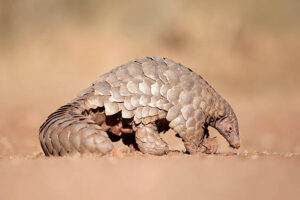The Giant Pangolin
Introduction:
The Giant Pangolin, a magnificent creature cloaked in intricately designed armor, stands as a sentinel in the heart of African landscapes. In this exploration, we delve into the fascinating world of the Giant Pangolin, examining its unique features, ecological significance, and the pressing need for conservation.

The Giant Pangolin: Armor of Legends
The Giant Pangolin’s most iconic feature is its remarkable scales, a living armor that adorns its entire body. Composed of keratin, the same substance found in human hair and nails, these scales serve as a formidable defense mechanism against predators. They create an otherworldly spectacle, capturing the imagination and earning the Giant Pangolin a place in the realm of legends.
Enigmatic Habitat and Range
Thriving in the tropical realms of Central and West Africa, the Giant Pangolin navigates a diverse array of ecosystems. From the dense embrace of rainforests to the expansive stretches of savannas, this elusive creature weaves its way through a mosaic of habitats, leaving researchers captivated by its adaptability and resilience.
Nocturnal Odyssey
Under the cover of darkness, the Giant Pangolin emerges as a silent nocturnal wanderer. Preferring the shroud of night, it roams the terrain with a purpose, guided by an acute sense of smell. Armed with claws and a tongue that can extend up to 40 centimeters, the Giant Pangolin engages in a nocturnal odyssey, foraging for its favorite delicacies—ants and termites.
Mysterious Reproduction and Family Bonds
The Giant Pangolin, typically a solitary traveler, reveals its familial side during the breeding season. While much remains shrouded in mystery, female Giant Pangolins nurture a strong maternal instinct, caring for their single offspring until it gains independence. The intricacies of their reproductive habits add an enigmatic layer to the species’ already mysterious nature.
Conservation Crossroads
Despite its majestic presence, the Giant Pangolin faces a perilous journey towards survival. Habitat loss, driven by deforestation, and the insidious illegal poaching for its scales and meat have pushed this species to the brink. The International Union for Conservation of Nature (IUCN) has classified the Giant Pangolin as vulnerable, signaling a critical need for immediate conservation actions.
Guardians Rise: Conservation Initiatives
In response to the urgent call for action, conservationists and researchers have rallied to safeguard the Giant Pangolin. Initiatives range from habitat preservation efforts and anti-poaching campaigns to educational programs aimed at raising awareness. Some nations have implemented stricter regulations to curb the illegal trade, illuminating a path toward the Giant Pangolin’s salvation.
Keystone Guardian: Ecological Impact
Beyond its enchanting exterior, the Giant Pangolin emerges as a keystone species, holding the delicate balance of ecosystems in its claws. Its insatiable appetite for ants and termites regulates their populations, preventing ecological imbalances. In this role, the Giant Pangolin becomes a guardian, ensuring the health and sustainability of its habitat.
Adaptations for Survival
Beneath the surface of its scales lies a host of adaptations that have evolved over time. Powerful claws aid in excavating termite mounds, and a highly developed sense of smell guides the Giant Pangolin in its quest for sustenance. These adaptations, finely tuned by evolution, showcase the species’ remarkable resilience and survival strategies.
Cultural Threads: The Pangolin’s Tapestry
Beyond its ecological significance, the Giant Pangolin threads its way into the cultural fabric of indigenous communities. Revered for its unique appearance, the species often features prominently in local folklore and traditions. Recognizing and respecting these cultural connections becomes integral to effective conservation strategies that harmonize with local communities.
The Quest for Knowledge: Research Challenges
Studying the Giant Pangolin poses an ongoing challenge for researchers. Innovative techniques such as camera traps and satellite tracking offer glimpses into the creature’s secretive life, yet much remains undiscovered. The quest for knowledge drives scientists to unravel the mysteries surrounding this species, providing hope for a more comprehensive understanding in the future.
Conclusion:
In the depths of African landscapes, the Giant Pangolin stands as a guardian of biodiversity, adorned in scales that tell tales of resilience and adaptation. As we strive to protect this enigmatic species, we embark on a journey not only to preserve a creature of wonder but to uphold the intricate tapestry of life that the Giant Pangolin embodies—a tapestry woven with scales, claws, and the timeless threads of ecological harmony.

3 thoughts on “The Giant Pangolin”